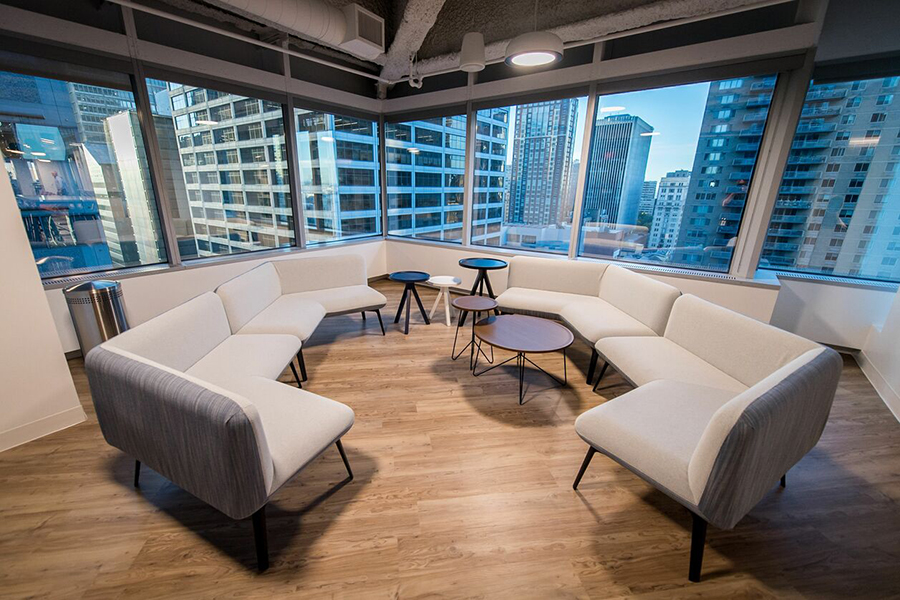Philly’s YMCA Was Struggling. After This Innovative Overhaul, Membership Is Up.

The Center for Innovation at Independence provides workspaces designed to encourage creative problem solving.
For years, the Greater Philadelphia YMCA’s membership had been on the decline. Like many institutions in Philadelphia, rapid expansion of new businesses was making the old way of doing business challenging. As gyms and community organizations proliferated, it had become increasingly rare for new members to settle down with the YMCA.
“We were experiencing what all organizations are going through right now, which is constant disruption,” says Joe Collins, the YMCA’s chief operating officer. “The question was, could this classic organization reinvent itself?” As part of a 178-year-old international institution that had done the same kind of work for decades, Collins and the YMCA’s other leadership knew there was a problem, but they weren’t sure if they could adapt to the new market.
Looking for solutions, the YMCA contacted the Independence Blue Cross Center for Innovation, located in a recently renovated space in the company’s headquarters on Market Street. The Independence Innovation team offers workshops and programs on how to apply design-thinking principles to everyday work.
“We believe in the expression, a rising tide lifts all boats,” says Michelle Histand, director of Innovation at Independence. “We’re working toward building a community that’s geared toward innovation and entrepreneurship.” The team has worked with Independence clients like Campus Philly, Temple University and Devereux Advanced Behavioral Health to develop new programs and solve longstanding challenges.
Histand’s team worked with the YMCA team to find the reason behind the YMCA’s declining membership and turn things around. The solution they would develop was surprisingly simple, but would revolutionize how customers thought of the YMCA.
The Connect Phase
“The question we were trying to answer was, ‘How might we better engage and retain traditional members in our first 90 days?’” says Joe Collins, chief operating officer of the Greater Philadelphia YMCA. Collins knew that members who stayed past 90 days tended to stay for good, but new memberships increasingly failed to reach this number. Independence’s Innovation team set to work trying to understand what was driving new members away.
“We start by trying to connect to the community to understand the opportunity at hand,” says Histand, referring to the first step of the Center for Innovation’s process, called the Connect phase. The Innovation team went out and spent weeks interviewing the YMCA’s current members, asking them what was working and what wasn’t, writing down the answers on sticky notes. When the YMCA staff met the Innovation team at its conference room, the room was literally filled with ideas.
“There were stickies all over the room,” says Collins. “The entire room became an amazing tapestry of colors and ideas and themes that could be distilled into a cogent strategy.” The stickies were remarkably consistent.
“We were not engaging and talking to members as well as we thought,” says Collins. “If there was anything that was surprising, it was the simplicity of what members were saying they needed—being engaged when they walked into the branch.”
The Cultivate Phase
With the problem identified, Histand and the Innovation team led the YMCA staff through the next step in the Innovation Center’s problem-solving framework, the Cultivate phase. The YMCA’s team was broken into four groups, with every level, from executive to staff, represented in each group. The Innovation team led these groups in practicing a growth mindset, monitoring the groups to steer them away from negative thinking.
“We knew that for some of our team, they were going to think, ‘Hey, we’ve been doing great, or we’ve always done it this way, why do we need to change?’” says Collins. “We’ve been around a long time, and we’re not always quick enough to consider new opportunities when we know what we do really well. The training helped us prime the pump for new ideas.” Applying the Cultivate approach, each group developed a proposal for addressing what they had learned in the Connect phase and presented it to the group for decision.
The Create Phase
The final phase is based around creating a solution to the problem that also offers the opportunity for ongoing improvement. After reviewing the proposals, the YMCA group decided to create a comprehensive membership experience program to address the problem. An engagement specialist was hired to greet members in the lobby and talk with them about their needs. Another staff member is now responsible for walking the building twice a day with an engagement checklist to observe staff and member interactions. And each morning and afternoon, all YMCA staff gather together to discuss problems and solutions. Already, the results of the program have been marked.
“We had been losing members,” says Collins. “Now, our retention has been increasing by two percent, and that remains steady, which is exciting.” The program has been so successful that they’ve instituted it in their new Willow Grove branch and presented it to a consortium of YMCA leadership across the country. Collins says that the Innovation team supplied them with the framework to continue implementing and improving their program into the future, but just as importantly, they taught them a new way to approach problems as a whole.
“I thought Independence was going to fill our minds,” says Collins. “Instead, they opened our minds. They helped us open ourselves up to a set of unlimited options as we experience new problems. That is the most powerful part of their contribution.”
To learn more about design thinking, including programs available through the Independence Blue Cross Center for Innovation, visit innovation.ibx.com.
This is a paid partnership between Independence Blue Cross and Philadelphia Magazine

